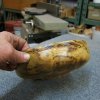Odie
Panning for Montana gold, with Betsy, the mule!
Recently finished a Tiger Myrtle bowl, and was wondering if anyone knows how this Oregon species gets the dark stripes.....?
I bought three of these Tiger Myrtle bowl blocks, and the one I chose to do first doesn't have much of the tiger figure......so, I'm showing you the other two roughed and seasoned bowls, as well. I chose the least figured one because I've never done Tiger Myrtle before, and didn't really know what to expect......if I get any surprises in the finishing, then I'd rather it be this one!
If you know something about the coloring and figure of TM, let us know what's what, please.......thanx
ko
I bought three of these Tiger Myrtle bowl blocks, and the one I chose to do first doesn't have much of the tiger figure......so, I'm showing you the other two roughed and seasoned bowls, as well. I chose the least figured one because I've never done Tiger Myrtle before, and didn't really know what to expect......if I get any surprises in the finishing, then I'd rather it be this one!
If you know something about the coloring and figure of TM, let us know what's what, please.......thanx
ko

